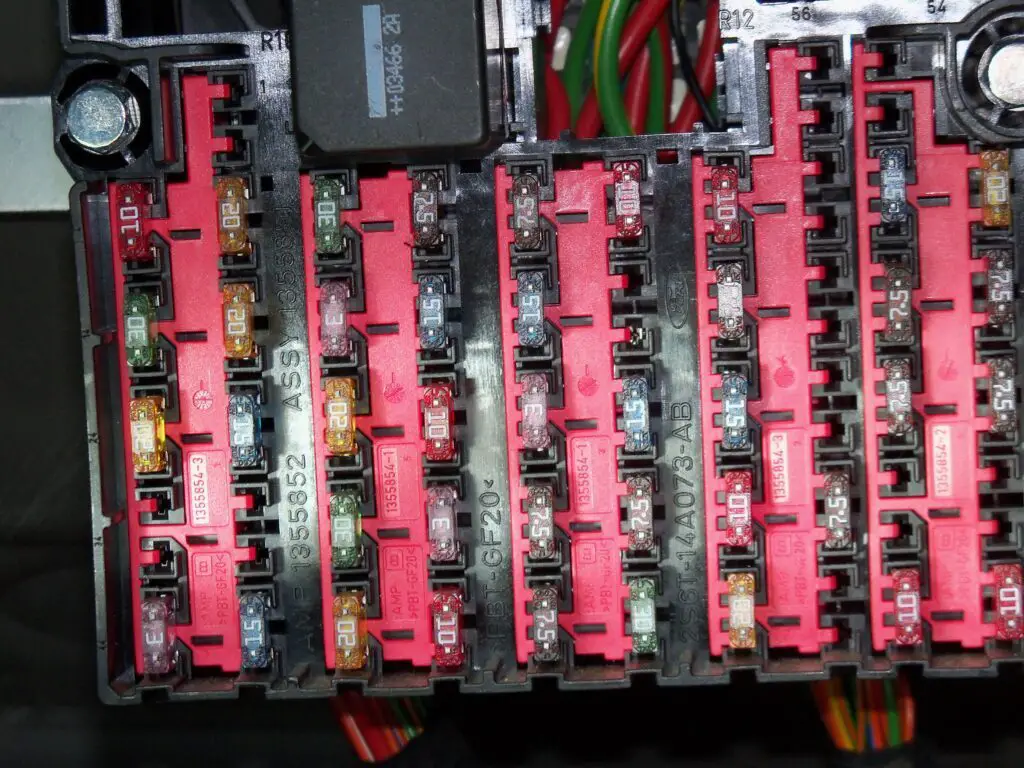Discovering liquid where electricity flows is alarming for any car owner. If your fuse box has become an unexpected swimming pool, take a deep breath – this guide will walk you through handling it safely.
We’ll examine the likely causes, potential dangers, and steps to dry it out, and even leverage some wisdom from the competition’s approach to provide a comprehensive perspective.
First, what causes water in car fuse box?
- Damaged windshield seals allowing rainwater intrusion
- Clogged sunroof drains forcing water to leak down A-pillars
- Improperly closed lids on underhood boxes allowing splash-in
Functions Of Fuse Box In Car
The fuse box acts like a central brain managing power distribution in your car. It contains a variety of fuses, relays, and in some cases circuit breakers that monitor and regulate electrical current flow.

Fuses are designed to melt and “blow” if current exceeds their rated capacity, opening the circuit and preventing damage or fire. Each fuse protects a specific circuit – for example, ones for brake lights, fuel pump, stereo, power windows, etc. They come in different amp ratings based on the normal current draw of that system.
Relays help manage functions that require high current only intermittently, like headlights, electric fans, etc. They use electromagnets to open or close their contacts – a low current circuit triggers the electromagnet which then closes the high current circuit. This allows a small trigger current to control a high-power device. Circuit breakers operate similarly to fuses but can reset after tripping, allowing normal operation to resume once the issue is resolved. These are sometimes used for higher-load circuits.
Within the fuse box, all these components are wired together in a systematic layout with the fuses, relays, and breakers clearly labeled. A diagram on the fuse box lid or the owner’s manual maps what each controls. Power is fed into the box through high gauge wires from the battery and alternator. It is then distributed out to the various car systems through the protective fuses, relays, and breakers. This centralized design makes diagnosing and servicing electrical issues easier.
The consequences can range from blown fuses to complete electrical failure. So addressing moisture in the fuse box promptly is critical.
Here’s a 10-step process to remove the water safely based on the competition’s recommendations but tailored and enhanced:
Step 1: Disconnect the Battery
Water in Car Fuse Box. Cutting power is crucial when working on electrical systems. As one competitor emphasized, always detach the battery’s negative terminal first to avoid shorts.
Step 2: Absorb Visible Water
Use towels to soak up standing water in the fuse box. For deeper amounts, use a turkey baster or pipette to siphon it out as suggested. Tilt the box to let gravity assist.
Step 3: Remove and Dry Fuses
Extract fuses one by one, noting locations as competitors advised. Could you gently shake out the water and allow it to fully air dry before reinstalling it? An oscillating fan can help speed evaporation.
Step 4: Check for Damage
Examine for blown fuses, corrosion, melted components, etc. One rival recommended using baking soda and a toothbrush to clean corroded fuses. Replace if unsalvageable.
Step 5: Dry With Compressed Air
Water in Car Fuse Box. Bursts of compressed air remove water from tight spaces as competitors suggested. Use low pressure and keep the nozzle moving to avoid spreading debris.
Step 6: Apply Heat With a Hair Dryer
If moisture remains, use a hair dryer as advised but in the coolest setting. Keep the blower moving constantly to prevent overheating sensitive components.
Step 7: Clean With Electrical Contact Cleaner
Spray contact cleaner on fuse clips to displace lingering moisture. This also prevents corrosion as one rival recommended.
Step 8: Reinstall Fuses
Once 100% dry, reinstall fuses in their documented positions. Please take a look at any removal notes or photos. Double-check alignments.
Step 9: Reconnect the Battery
With everything dried out and reassembled, reconnect the battery starting with the negative terminal as competitors suggested.
Step 10: Verify Proper Operation
Start the car and turn on electrical systems like lights, radio, and charging to confirm all works correctly. Drive short distances to further test.
That covers the key steps to address water in the fuse box using guidance from competitors. Taking it slow and careful will revive your car’s electronics safely. But if issues persist, professional assistance may be required.
FAQS – Water in Car Fuse Box
Can water damage car fuses?
Yes, as one rival pointed out, water can corrode and short fuses over time. The minerals in water create problematic conductive paths.
What to do if water gets in your fuse box?
Act quickly to cut power and follow the drying process above. If fuses blow or components fail later, inspection for hidden water damage is recommended.
Can a car fuse box overheat?
Absolutely. As competitors noted, fuse boxes handle high currents and can overheat from electrical faults. Signs include burning plastic smells or visible melting/warping.
How do you clean a car fuse box?
Use short compressed air bursts to remove dust as rivals suggested. For grime, use an electronics-safe cleaner and a toothbrush. Avoid washing that can force water past seals.
Can water trip a fuse?
Yes, water can provide an unintended current path potentially blowing a fuse. One competitor explained it diverts current away from the designed circuit.
Can fuses get wet?
As one rival noted, fuses can withstand some moisture but prolonged wetness can still damage their metal components and wiring. Always dry fully.
Those cover some key questions on water and fuse boxes.
The core takeaways – Water in Car Fuse Box
- Safely cut all power to the fuse box before working on it
- Absorb standing water and open up the box to maximize drying
- Clean all components and check closely for any damage
- Allow to dry fully before reassembling and reconnecting power
- Verify electrical systems operate correctly before driving
Water in Car Fuse Box. With care and patience, you can likely revive a waterlogged fuse box. But if issues persist, seek professional help to assess for hidden damage. Your car’s health depends on its electrical center!
Hopefully, this provides reassurance and a robust game plan if your fuse box resembles a fish pond. Stay safe, take it slow, and you’ll be back on the road in no time. Just remember to breathe and tackle it one step at a time.





